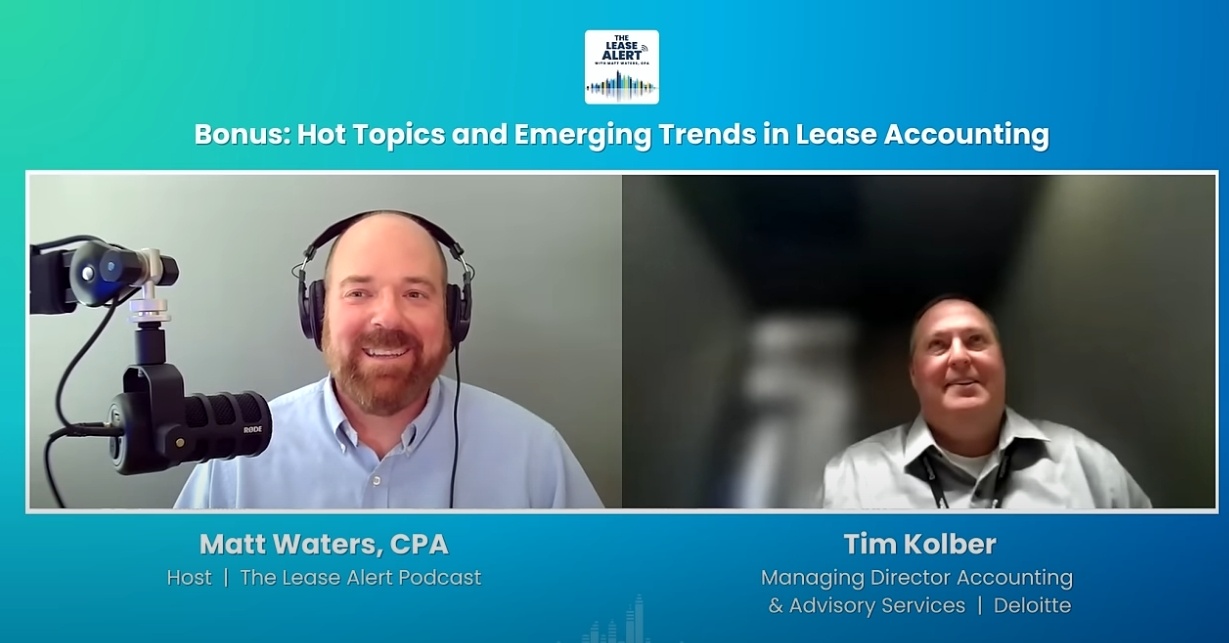Share this
by Matt Waters, CPA on June 9, 2016
If you’re part of your organization’s team to address the recent FASB and IASB changes, then here are 10 important questions (and answers) for tackling new lease accounting standards that you should consider.
1. What’s the first step to consider for tackling new lease accounting compliance?
Make a plan to consolidate all organizational lease data into one department and one system. The accounting group is the logical departmental choice due to the technical nature of lease reporting requirements. And while other departments may retain responsibility for engaging new leases, the ideal technology solution will manage input from multiple sources and provide administrative insight to key organizational stakeholders.
CoStar Real Estate Manager’s platform provides out-of-the-box functionality for both real estate and accounting team members and enables organizations to approach lease accounting compliance with functionality like classification tests, journal entry generation and lease data assessments.
2. What’s the biggest obstacle to overcome for the new lease accounting guidance?
Data collection is the biggest obstacle. Leases contain voluminous amounts of data and must be organized in a consistent fashion to comply with new guidelines. Lease data is often housed and tracked in separate departments like real estate for properties, logistics for trucks and IT for computer equipment. While purchase decisions can remain with those departments, it is recommended to house the data centrally. Centralized data also enables lease procurement analysis, which can lead to opportunities for cost reductions and other savings.
3. What’s the best decision organizations can make that will provide a significant advantage when preparing for the new lease accounting guidance?
Choose the right system. Your system should handle much more than accounting, but the accounting department should be heavily involved in the selection of the system and should make sure technical accounting requirements can be met.
Significant thought should be given to selecting a software that will meet the needs of all departments. Some software solutions have been developed directly in response to new FASB and IASB rules. You should find out if the software you’re considering was developed and tested with the help of accountants specifically for accounting team use.
The system should include standard reports and also allow for custom reports, preferably with ability for your team to build and edit reports as needed. Most importantly, it must be able to provide audit trails and track all data changes. To ensure compliance with Sarbanes Oxley’s requirement to demonstrate effective internal controls and procedures for financial reporting, an ideal platform will complete an SSAE 18 audit annually.
4. How can my organization find hidden value while simultaneously preparing for the new lease accounting guidance?
Lease consolidation is an opportunity for big cost reductions. For example, what if the lease review process uncovers payments for leased equipment that is no longer in use? When your data is in one place and organized, you can see patterns which lead to savings.
For accounting, the win is not just in preparing for new standards. Organizing lease data can add a high amount of efficiency to the existing process of pulling lease data for 10K reporting, bank reporting and more.
5. What team members should be assembled to address the new lease accounting guidelines?
You need representatives from Accounting and IT as well as input from each area of your company involved with leases including real estate and logistics. Assigning a dedicated project manager is also an essential part of best practices for tackling this effort.
For public companies, a good starting point is last year’s 10K lease commitment schedule. The working papers from that schedule should give you a good idea of which departments will need to be involved.
An ideal software provider like CoStar Real Estate Manager can help with the IT and project management components by partnering with your internal resources, or through a full-service solution working mostly with your accounting department.
6. What kinds of objections are expected from internal stakeholders when preparing for the new lease accounting guidelines, and how should they be addressed?
The most common objection from internal stakeholders is related to concerns over losing control of resources needed to run the business. A traditional benefit of leasing is the flexibility that it offers the business, and operators can express concerns regarding loss of control resulting from centralizing the leasing function. It is important to point out that consolidating lease data into one location is intended to add value to the existing leasing process, not take away. Business operators will still be able to utilize the benefits of the leasing software, but with added functionality for the reporting and tracking of lease metrics.
7. How do I account for leases with a term of 12 months or less?
The FASB decided that for leases with a term of 12 months or less, a lessee is permitted to make an accounting policy election by class of underlying asset not to put short term leases on the balance sheet with lease assets and lease liabilities. If a lessee makes this election, it should straight-line lease expense over the lease term.
8. What is retrospective and modified retrospective, and how does that impact my organization?
The FASB decided to mandate the modified retrospective transition method rather than a more onerous transition approach (for example, a full retrospective approach). The practical effect of the modified retrospective transition method, particularly when combined with the practical expedients that are offered, is that an entity will “run off” those leases existing at the beginning of the earliest comparative period presented in accordance with previous GAAP with the exception that, for operating leases, a lessee will present a lease liability and a right-of-use asset.
9. What happened to the bright line tests?
Bright line tests for lease characterization are replaced by more flexible criteria; The seventy-five percent of useful life test is replaced by “major part of the remaining economic life” while ninety percent of fair market value is replaced by “substantially all of the fair value of the underlying asset.”
This new wording gives your business the flexibility to set the accounting policy based on the nature of the underlying transactions. You can still essentially use the bright line tests, but you can set the thresholds at a meaningful level for your company.
10. When do I actually need to start calculating and presenting numbers based on the new guidance?
A: For most companies, the new guidance is effective for reporting fiscal years that begin after December 15, 2018. With a required two-year look-back, that means data must be updated as of December 16, 2016. That’s just a few months away, so the time to get lease data organized is now.
Share this
- Lease Accounting Software (90)
- ASC 842 (83)
- Accounting Teams (52)
- Lease Administration Software (27)
- Retail Tenants (16)
- Commercial Real Estate (14)
- Lease Management (12)
- Real Estate Teams (9)
- ESG (8)
- Market Data and Analytics (8)
- Success Stories (8)
- News and Media Coverage (5)
- Transaction Management Software (2)
- frs 102 (2)
- Customer Success (1)
- Office Tenants (1)
- September 2025 (1)
- July 2025 (2)
- June 2025 (4)
- May 2025 (2)
- April 2025 (2)
- March 2025 (6)
- February 2025 (3)
- January 2025 (4)
- December 2024 (1)
- October 2024 (4)
- September 2024 (2)
- August 2024 (4)
- July 2024 (3)
- June 2024 (3)
- May 2024 (4)
- April 2024 (1)
- February 2024 (1)
- December 2023 (4)
- November 2023 (6)
- October 2023 (4)
- September 2023 (2)
- August 2023 (2)
- July 2023 (3)
- May 2023 (2)
- March 2023 (1)
- February 2023 (3)
- January 2023 (1)
- December 2022 (3)
- November 2022 (4)
- October 2022 (4)
- September 2022 (1)
- August 2022 (4)
- June 2022 (1)
- May 2022 (4)
- April 2022 (8)
- March 2022 (3)
- February 2022 (1)
- January 2022 (2)
- November 2021 (2)
- October 2021 (2)
- September 2021 (3)
- August 2021 (15)
- July 2021 (3)
- June 2021 (1)
- May 2021 (1)
- April 2021 (3)
- March 2021 (1)
- January 2021 (1)
- December 2020 (3)
- November 2020 (1)
- October 2020 (2)
- September 2020 (2)
- August 2020 (3)
- July 2020 (2)
- June 2020 (3)
- May 2020 (1)
- April 2020 (1)
- March 2020 (1)
- February 2020 (1)
- December 2019 (1)
- October 2019 (1)
- September 2019 (2)
- August 2019 (3)
- July 2019 (2)
- April 2019 (69)
- October 2018 (1)
- August 2018 (1)
- July 2018 (1)
- June 2018 (1)
- May 2018 (1)
- April 2018 (2)
- March 2018 (3)
- February 2018 (2)
- December 2017 (1)
- August 2017 (3)
- June 2017 (2)
- May 2017 (2)
- April 2017 (1)
- March 2017 (2)
- January 2017 (2)
- November 2016 (2)
- July 2016 (1)
- June 2016 (1)
- July 2015 (1)
- March 2015 (1)
- June 2014 (1)
- April 2014 (11)
- October 2011 (1)
You May Also Like
These Related Stories

10 Key Questions to Assess Lease Accounting Software Solutions

Lease Accounting Compliance – 3 Critical Steps for Success



